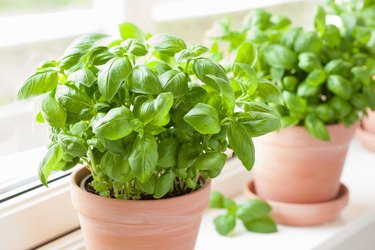
An herb garden is a great starting point for new gardeners to try their hand at growing edible plants since herbs tend to be easier to grow than most fruits and vegetables, and annual herbs are particularly rewarding. That's because annuals have a life cycle that only lasts one single year, meaning you can usually start harvesting within a month or so of planting seeds (unlike perennial herbs, such as sage [Salvia officinalis, USDA zones 4-10] or rosemary [Salvia rosmarinus, formerly Rosmarinus officinalis, USDA zones 7-11], which can take six months or even a few years to reach the harvest stage). Plus, you don't have to worry about winterization, and there's no guilt if one of your herbs doesn't survive its first year. Fresh culinary herbs tend to taste more vibrant and flavorful than dried ones because you can grow these plants in a short period of time, and annual herbs also provide you with a great opportunity to try new herb varieties, like licorice basil.
1. Basil
Video of the Day
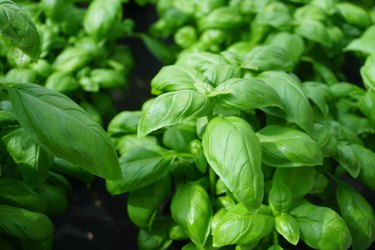
Basil (Ocimum basilicum) is one of the most popular herbs around the world and is also one of the best annual herbs for new gardeners. Its large, flavorful leaves make a delicious addition to salads, soups, pastas and sauces. There are as many as 150 different types of basil, and while the most popular is sweet basil, you might also want to experiment with other flavors, like the Genovese, Thai, cinnamon or licorice types.
Video of the Day
Basil's natural life cycle is never particularly long, but it will live the longest in very warm weather, like that found in zones 10-11, where it will be safe from cold snaps. Plant basil in an area with full sun only after all threat of frost has passed or grow it indoors because it cannot survive even the smallest amount of frost. Space plants between 12 and 18 inches apart. Keep the soil moist but not wet.
You can use kitchen or herb scissors to harvest basil leaves as soon as it has plenty of large, fully grown leaves (around 50 days after planting), and regular harvesting will help encourage more leaf growth. Do not harvest more than a third of the leaves at once during the growing season. Pinch off flowers as they start to appear to extend the life of your plants a little since seeding causes the leaves to taste bitter and start to die off.
2. Cilantro

Cilantro (Coriandrum sativum) is a two for one since you can eat the bright-green, divided leaves and long, thin stems (which are commonly referred to as "cilantro") as well as the spicy, citrus-flavored seeds (which are usually called "coriander"). Both cilantro and coriander are widely used in all types of international dishes, including salsa, guacamole, chimichuri, stir fries, chutneys, curries, pickles and more.
Cilantro is mildly frost tolerant and should be sown in early spring in zones 3 through 8. In zones 9 and higher, it is best to plant in late fall. Sow cilantro seeds 1/2 inch deep in an area with full sun in cooler climates and an area with partial shade in warmer zones. Keep the soil moist but make sure it never gets soggy. You can harvest sprigs from the base with scissors once they're large enough (this will be about two to three weeks after the seeds germinate) but never take more than a third of a plant at a time.
Hot weather will trigger cilantro to go to seed, and foliage will begin to die off at this point. When brown seed heads appear, trim these and use a clothespin to hang them upside down in a paper bag until the husks open a few days later, leaving the tasty coriander seeds to fall into the bottom of the bag. You may also want to leave a few seed heads on the plant because cilantro self-seeds easily and will grow year after year if allowed to go to seed outdoors.
3. Parsley
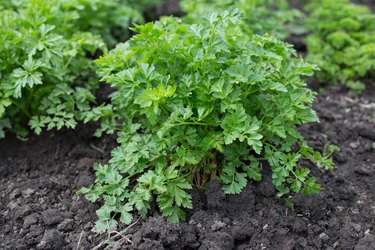
Parsley (Petroselinum crispum) is mildly frost tolerant and is a great outdoor herb for zones 7 and warmer, where it technically grows as a biennial, though most gardeners grow it as an annual because the flavor is better in its first year. While curly parsley with its frilly, deep-green leaves is the best-known variety of this plant, don't overlook Italian flat-leaf parsley, which is better suited to warm summer weather. Flat-leaf parsley is also prized for its ability to survive the cooking process better than its more famous cousin. Keep in mind that Italian parsley looks notably similar to cilantro, though, so if you grow both plants, be sure to add markers so you don't confuse one for another.
Plant parsley in early spring once the soil is workable, spacing 6 to 8 inches apart. In cooler areas, the plant requires full sun, but in warmer locations, offer partial shade to protect it from the hot afternoon sun. Grow it in well-draining soil and water regularly whenever the top inch of soil feels dry. Sprigs can be harvested at the base with scissors once they are large enough to use (around 80 days after planting) but be careful to never use more than a third of the plant at once. Harvest the entire plant at the end of the season and replant the following year to ensure you always have great-tasting parsley on hand.
4. Anise
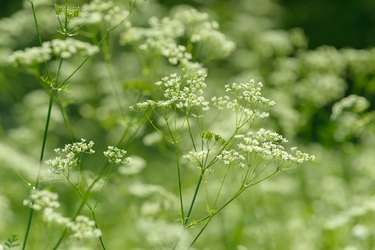
With its lacy white flowers and delicate, feathery foliage that reaches up to 2 feet tall, anise (Pimpinella anisum) is a great annual herb to grow for aesthetic purposes, though the seeds and leaves are prized for their licoricelike flavor that makes a great addition to breads, salads, pastries, pickles and more. It's worth noting that because anise and fennel (Foeniculum vulgare, USDA zones 4-9), which is a perennial, are cousins of the same plant family and are commonly mistaken for one another, the "anise bulb" sold in grocery stores is actually just mislabeled fennel bulbs. Do not expect to harvest bulbs from your anise plants.
After the threat of frost has passed in your area, plant anise in a sunny spot that is sheltered from the wind, spacing plants approximately 6 to 18 inches apart. You'll generally want about 12 plants to ensure you have enough seeds with which to cook throughout the year, and if you end up with extra, the good news is that they can last up to four years. These plants do not like excessive moisture, so water only when the soil starts to dry out and do not overwater. You can harvest leaves by snipping them off with scissors as needed throughout the growing season.
Flowers bloom in early summer to midsummer, and the rest of the foliage will die off soon afterward. Like the coriander seeds on cilantro, the seeds are best harvested by cutting stems containing seed heads and then hanging them upside down inside the top of a paper bag so you can catch the seeds as they fall. Pasteurize seeds in an oven set at 100 degrees Fahrenheit for 15 minutes prior to storing.
5. German Chamomile
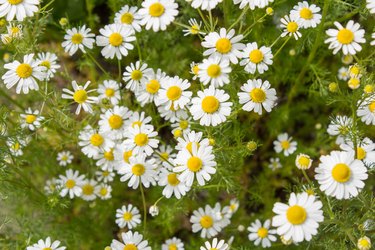
German chamomile (Matricaria chamomilla) is easily identified by its fernlike foliage that reaches up to 3 feet tall and its white flowers that look like small daisies and can be used to make herbal teas. While it shares many similar characteristics with its perennial cousin, Roman chamomile (Chamaemelum nobile, USDA zones 4-9), German chamomile is an annual. Be aware, though, that while this plant dies off after the growing season, it is such a prolific self-seeder that it is often considered a weed. For this reason, be cautious if you plan to grow this plant in your yard and don't want to see it year after year, especially if you live in zones 5 through 8, where this plant does particularly well.
After the last threat of frost has passed, plant German chamomile in sandy soil, spaced about 8 inches apart. German chamomile requires full sun or light shade and only needs to be watered occasionally when the soil is fully dry. The plants will bloom throughout summer starting about a month after the seeds are planted and should be harvested before the flowers begin to dry out on the stem. When harvesting, take care to snip off the entire stem because only the flower should be used in tea.
While fresh flowers can be used for tea, most people choose to dry them since they last longer. Dry them in a warm, dark area and store them in a sealed container for up to a year. One cup of tea requires 1 teaspoon of dried flowers or 2 teaspoons of fresh flowers.